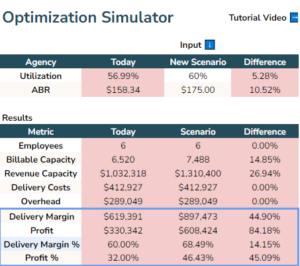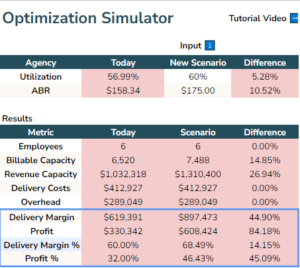In this one-of-a-kind solo cast episode, Marcel talks about what it takes to make the 4 day work week a profitable reality.
Introduction
Doesn’t a 4 Day work week sound like a dream? Long weekends…indefinitely.
If you run a company in the professional services space, you’ve probably been feeling some pressure around this idea. Your team might be asking about it, or you’re looking for an edge to compete for talent. The question is, how can you make it work?
In this post, we’ll unpack the context and the math you can use to work through just about any situation related to changes in expectations around working hours, PTO, including all the variations of the 4 Day work week you might be hearing about these days.
The Traditional Work Week in Agencies
Historically, agencies have been known for running something more like a 6 or 7 day work week. Our industry has been notorious for toxic cultures of evening and weekend work combined with predatory hiring practices aimed at young, vulnerable talent (including underpaid or completely unpaid interns). Thankfully, much of that has changed and the industry as a whole has started becoming more balanced in recent years. However, most professional services firms are squarely subscribed to a standard 5 Day work week (barring extenuating circumstances).
While other industries seem to be embracing reduced and flexible working schedules, agencies and service firms seem to be lagging behind. It’s no surprise really, because the 4 Day work week (in whatever form it takes) works against the professional services business model. At a fundamental level, firms are in the business of selling time (regardless of how they decide to price or package their services). When I speak to agency owners about this, they often rebuke this notion. They don’t like to think of themselves as time brokers and often point to productized services, value-based pricing and other forms of pricing that steers them away from the billable hour as business model change.
Unfortunately, changing your pricing model doesn’t affect the underlying economics of a service firm. And in the context of the 4-day work week, decoupling time from money often makes it even more expensive to decrease capacity in terms of opportunity cost. The objective of these pricing models is often to separate time and billing such that less time can be spent to earn the same amount of revenue, thereby increasing the firm’s ABR (Average Billable Rate). In that context, the value of every additional Delivery Hour increases, which means that the opportunity cost of reducing capacity via the 4-day work week (or any other form of alternative work arrangement) actually increases since the delivery hours you’re giving back to your team are each worth more than they were before.
Don’t worry, we’ll do real math on this later.
At a fundamental level, it comes down to one simple fact:
Agencies are struggling to embrace the 4 Day work week because they aren’t incentivized to do so. In fact, they’re incentivised to do the exact opposite, and maximize the amount of labor they are able to extract from their workforce at any given time.
While this fact makes it more difficult for a firm to move towards a shorter work week, it doesn’t make it impossible. There is very simple math that will allow any firm to work through the cost of changes to their working model, and understand the possible levers available to compensate for that cost.
Unpacking the 4 Day Work Week
First, we should make sure we’re on the same page about what a 4 Day work week means. It could mean…well, a lot of things. In my discussions with firm owners and teams, there doesn’t seem to be any clear consensus about what qualifies as a 4-Day work week and what doesn’t.
For example:
- It may mean that you’re removing one workday’s capacity from your team’s total capacity. Typically that means everyone works 8 hours less, per week, indefinitely.
- It also might mean that you only work for 4 days a week, but you’re doing the same amount of work (without adjusting capacity).
- Or, maybe it’s something in between, with more flexibility for your team, internal work-only days, meeting blackouts, or something else.
Anecdotally, I have observed that the most common underlying expectation for a 4 Day work week is primarily related to a reduction in capacity. Meaning that for most people, it’s more important that the total volume of hours they work each week is reduced, the idea that this is actually constrained to 4 days is much less important.
Conversely, working 40 hours per week over 4 days is often regarded as not qualifying as a “legit” 4 Day work week, but that point of view hasn’t been consistent from my experience.
With all that said, no matter how you define a 4 Day work week, or any other kind of adjustment to your working model – the label isn’t what’s important. It’s the intention, and the math behind it that does.
The questions we must answer when navigating any of these possible scenarios are the following:
- Does this way of working meet the underlying needs of our team and help us achieved the desired impact on culture, lifestyle or talent acquisition and retention?
- How will this impact our capacity?
- How will this impact our utilization?
- How are we going to pay for it?
Let’s unpack the math you can use to work through the last three questions in that list.
Example – Mathematics of a 5-Day Work Week
We’ll start with a fairly standard example of an agency with a team of 20 full-time employees.
| Delivery Expenses | Overhead Expenses | Capacity (hours) | Utilization | Delivery Capacity | ABR | AGI | Delivery Margin % | Profit |
| $1.8M | 950k | 41,600 | 55% | 22,880 | $150/h | $3.42M | 47% | 19% |
Let’s run through the first row to show you what these numbers mean.
Delivery Expenses: This is mostly payroll expenses related to the delivery team, as well as some shared delivery expenses. This example assumes the team of 20 has an average salary of just under ~$90k annually, and a total of 1.8M in Delivery Expenses which represents 53% of AGI (Agency Gross Income).
Overhead Expenses: Pretty standard – fixed overhead cost for admin, S&M, facilities, and shared delivery expenses. This example assumes a very average 27.7% of AGI going to overhead expenses.
Capacity: This represents the total capacity the firm is purchasing from their entire team via their employment contracts. The number you’re seeing (41,600) is annual, so 2080 hours a year * 20 employees. A typical employee working 40 hours a week will do around 2080 hours a year.
Utilization: This is how much of the team’s time will be spent working on client deliverables (regardless of whether or not they’re billing those hours to the client). This is a team-wide value, so it would include those who don’t do any client delivery work at all. If you’d like to calculate your own Utilization capacity you can do so here.
Delivery Capacity: This number is the Capacity * Utilization (41,600 * 0.55) and what it’s saying is that if this team was able to hit all of their targets and did spend 55% of their time on delivery work, they’d be working on client projects for 22,880 hours out of the available 41,600 total.
ABR (Average Billable Rate): This is the average revenue that this team earns for every hour that they work on a client project. For example, if they worked on a client project that brought in $10,000 in revenue, and your team spent 90 hours on it, they earned $111/h for the agency.
AGI (Agency Gross Income): This is the number that the agency can be expected to bring in after subtracting pass-through expenses that flow through the firm onto other vendors. This is calculated by multiplying Delivery Capacity by ABR
Delivery Margin: This value indicates the percentage of every dollar of AGI that is left over after client work has been completed, and the cost of delivery has been incurred. It’s calculated with the following formula:
Delivery Margin = AGI – Delivery Costs / AGI
Which gives us:
3,420,000 – 1,800,000 / 3,420,000 = 47%
Profit: Hopefully you’re familiar with this one. We subtract Overhead Expenses and Delivery Expenses from AGI which leaves us with a profit of $670k. This represents a 19% profit relative to AGI.
As you can see, the example above is a fairly standard agency model with a slightly above-average profit margin. Now, let’s explore how shifting to a 4 Day work week would impact this firm’s economic model.
Example – Mathematics of a 4-Day Work Week
For the example, we’re going to model the impact of moving to a version of the 4-Day work week which consists of reducing each individual employee’s capacity by 1 workday per week (or 8 hours per week) while holding everything else constant.
| Delivery Expenses | Overhead Expenses | Capacity (hours) | Utilization | Delivery Capacity | ABR | AGI | Delivery Margin % | Profit |
| $1.8M | 950k | 41,600 | 55% | 22,880 | $150/h | $3.42M | 47% | 19% |
| $1.8M | 950k | 33,280 | 55% | 18,304 | $150/h | $2.75M | 34% | 0% |
You’ll notice a material change in:
Capacity: With 20 employees working 32 hours a week, we’re now looking at 33,280 in total capacity compared to 41,600 in the previous example.
Delivery Capacity:Assuming the percentage of capacity that is expected to be utilized for client work remains the same, which will in turn decrease the team’s Delivery Capacity to 18,304 hours.
AGI: What this means now, is that with only 18,304 hours to work on client deliverables, this team can only (in a model scenario) output (18,304 * 150) = $2.75M in AGI. Compared to a $3.42M in AGI from the previous 5 Day work week example. What this effectively means is that the firm’s AGI capacity has dropped by $680,000 per year.
Delivery Margin: With AGI at 2.75M, but Delivery Expenses staying the same (everyone is still being paid the same amount) Delivery Margin slips down to just 34% compared to 47% in the previous example
Profit: Similarly, holding Overhead Expenses the same (which is likely to be the case) this firm’s entire bottom line has been wiped out leaving the firm operating at, or just below breakeven.
At first glance, it might seem like a 4 Day work week is impossible for this firm, but that’s not necessarily true.
What we can gather from this example is that the cost of installing a 4 day work week to this firm (relative to their current 5-day model) is about $680,000. The question is, how do we pay for that cost?
There are several ways to do just that. All of them are simple, but not necessarily easy, let’s break them down…
Example – Making the 4 Day Work Week Make Sense
To make the numbers make sense on a 4 Day work week, there are three primary levers: ABR, Utilization and Cost Cutting.
Lever 1 – ABR
The first and most attractive option is to effectively pass the cost of this adjusted work week onto clients by increasing average billable rates.This doesn’t necessarily mean raising prices, as an increase in ABR can be achieved by spending less time to earn the same revenue via process improvements, etc.
We can solve for what your ABR will need to be to achieved in order to support this 4 Day work week model using the following formula:
AGI / Delivery Capacity
Start by taking the original AGI (Agency Gross Income) that the 5 Day work week team was able to achieve, which was $3,430,000 annually, and divide that by the 4 Day work week Delivery Capacity that your team has available to work on client work, which was 18,300.
Target ABR = $3,430,000 / 18,300
Target ABR = $187
What this means is, this firm would need to increase their ABR from the original $150/h by about 25% to $187/h to reach the same level of AGI that it had while the team was on a 5 Day work week, making the 4 Day work week feasible.
Here’s what the new table looks like:
| Delivery Expenses | Overhead Expenses | Capacity (hours) | Utilization | Delivery Capacity | ABR | AGI | Delivery Margin % | Profit |
| $1.8M | 950k | 41,600 | 55% | 22,880 | $150/h | $3.42M | 47% | 19% |
| $1.8M | 950k | 33,280 | 55% | 18,304 | $187/h | $3.42M | 47% | 19% |
Did you know?
Parakeeto offers a totally free toolkit where you can automatically generate your Delivery Margin and other profitability metrics using our Optimization Simulator. Here is what that looks like:

Lever 2 – Utilization
In the event that raising ABR by 25% to $187+ isn’t feasible, or that ABR increase can only get the firm part of the way there, there’s another efficiency lever that can close the gap — Utilization.
Utilization measures what percentage of the firm’s total capacity is utilized for client work. The formula is the following:
Utilization = Capacity / Delivery Capacity
In our 5 Day work week scenario, we had the following:
| Capacity (Hours) | Utilization | Delivery Capacity |
| 41,600 | 55% | 22,880 |
But in our 4 Day work week scenario, it looked like this:
| Capacity (Hours) | Utilization | Delivery Capacity |
| 33,280 | 55% | 18,304 |
In order to determine the utilization rate needed to fully compensate for the AGI difference between the 5 Day and 4 day work weeks, we can simply divide the 4 day work week capacity by the 5 day work week Delivery Capacity:
22,880 / 33,280 = 69%
What this means is that the firm would need to hit a 69% Utilization Rate to achieve the same level of AGI with a 4-day work week scenario as they would have in the 5-day work week scenario. Here’s what that would look like across the board:
| Delivery Expenses | Overhead Expenses | Capacity (hours) | Utilization | Delivery Capacity | ABR | AGI | Delivery Margin % | Profit |
| $1.8M | 950k | 41,600 | 55% | 22,880 | $150/h | $3.42M | 47% | 19% |
| $1.8M | 950k | 33,280 | 69% | 22,963 | $150/h | $3.42M | 47% | 19% |
A Combination
The most likely scenario is that a combination of these two levers would be combined in order to close the gap.
In our experience, some material improvements to ABR can quickly be achieved by looking to increase efficiency (usually done through effective processes, templates and systems), or charging more for services via an optimized pricing model.
Firms in this situation can also usually improve Utilization across the team by focusing on compressing non-Delivery work (Admin, Sales, Marketing).
Here is what a combination of an improvement in both numbers could look like:
| Delivery Expenses | Overhead Expenses | Capacity (hours) | Utilization | Delivery Capacity | ABR | AGI | Delivery Margin % | Profit |
| $1.8M | 950k | 41,600 | 55% | 22,880 | $150/h | $3.42M | 47% | 19% |
| $1.8M | 950k | 33,280 | ~61% | 20,350 | $168/h | $3.42M | 47% | 19% |
Interested in building out these scenarios on your own? The Agency Profit Toolkit’s “Agency Model Simulator” spreadsheet is one of many that will help with just that.

You can grab your copy of the toolkit for free below!
Lever 3 – Cost Cutting
If increasing efficiency is out of the question, a third (but often less desirable) option is to cut costs. It’s important to remember that by focusing on cost-cutting over efficiency improvement, the firm will be adjusting their AGI down to whatever the revenue capacity is in the 4-day work week model. The objective in this cost-cutting instance is to bring costs down in order to maintain the ratio of profitability relative to AGI, but will result in lower absolute profit.
Essentially this means taking the percentages of AGI spent on Overhead and Delivery and applying them to the new AGI number in order to establish new budgets.
For example, we would calculate our budget for Overhead Expenses by taking our 4 day work week AGI metric, keeping all other numbers constant (2.75M) and multiplying that by the percentage of overhead previously spent on the 5 day work week, which in this case would be about 28%.
2,750,000 x 0.28 = $770,000
This means in order to maintain the same overhead ratios, the firm would need to cut their overhead spending by roughly $180k to bring expenses down from $950k to $770k. The most common way to achieve this in a 4 Day work week scenario is by adjusting the team’s compensation down to reflect the time they’re getting back, although this is not generally a popular option or one that will be quickly volunteered by the team.
The same thing can be done with Delivery Expenses. They were previously 1.8M, which represented around 53% of the original AGI Capacity in the 5 Day work week model. Multiplying the AGI Capacity in the 4 Day work week scenario by 53%, leaves us with a new Delivery Expense target of 1.4M:
2,750,000 x 0.53 = $1,440,000
Similar to overhead, this means the firm will need to cut about $360k from their Delivery Expenses budget to bring it down from $1.8M
In the end, the net profit of this business will still be around 19% of AGI, but since AGI will have decreased to $2.75M, that will equate to an absolute profit amount in the range of $525,000 (about $145,000 less than the original profit number of $670,000)
While this lever is probably the least enticing, it’s still an option. Barring salary adjustments to existing team members, successfully lowering Overhead Expenses might mean picking and choosing which services are essential, and where austerity measures can be taken to reduce costs. On the Delivery Expenses side however, these cost reductions can be made through a recomposition of the team. For example, investing in streamlined systems and processes so that work can be delegated to more junior or offshore team members is an option, thereby lowering payroll cost as the team is re-composed.
Potential Challenges for Agencies Moving to a 4 Day Work Week
Aside from the mathematical hurdles to consider when moving to the 4 Day work week, cultural changes will need to be considered to make your transition successful. Here are a few helpful prompts that may open up conversations sooner rather than later:
- If you’re not working on one day of the week, how will that impact your client interactions?
- What about onboarding and expectation setting?
- Are any of your deliverables or meetings typically landing on the day you’re removing?
- How will this impact your PTO
- What will the expectations be for the day that’s now gone?
- Will your team still be checking their emails?
- What about emergencies?
- What about your internal meetings? Should those still happen on those days?
- Will this have any impact on anyone’s compensation?
- What kind of impact will it have on your freelance/contractor teams?
- What happens if it doesn’t work? Are there next steps in place and expectations with your team that it might not be forever?
Depending on the shape this adjusted working model takes for your firm, there could be many other cultural and logistical considerations to work through. As you can see, it is possible, but likely that this change will touch every facet of your business in some capacity and require a very deliberate shift in processes and culture.
Additional Tips for Implementing a 4 Day Work Week
Here are a few things to keep in mind when making this transition:
Make it a Collaboration w/ the Team
Ensure that you’re laying all of the options out on the table for your team, so that nobody in this scenario is left out to dry. You’ll likely be picking and choosing areas to pull back on, which is sure to impact roles and responsibilities…not to mention relationships. Be careful to listen to feedback so that this change doesn’t do more harm than good.
In my experience, the most effective strategy is to lay out the math just like we did in this post, and recruit the team to discuss how the available levers can be pulled in order to “earn” the right to buy back a day of capacity each week (or whatever version of the 4 Day Work Week you’re considering).
Make it an Iterative Process
Just as it’s unlikely that you skyrocket one particular metric (like ABR) without the others, ensure you’re also experimenting with where it can/can’t work. Try a month at a different Utilization rate, or a different pricing model for the following month. Recognize that this is likely to be a fine tuning process, rather than a “crank the dial and step on the gas” type of rollout.
Set Expectations with your Team
Similar to how you onboard your clients, you’ll need to onboard your team to these ideas and set expectations that it’s unlikely to be an instantaneous success. Ensure they know the plan, contribute to the plan, and understand what will happen if things don’t go as planned.
That way, you’ll all be in it together.
Conclusion
As we progress through 2023, the year proves to be somewhat turbulent for professional service agencies due to economic uncertainty. However, in order to ensure favorable outcomes for your clients, it’s crucial to focus on hiring and retaining top talent. Unfortunately, many of the traditional incentives (pizza parties anyone?) are losing their effectiveness as a recruitment and retention strategy.
Implementing a 4 Day Work Week can be a viable solution to promote a healthy work-life balance, increasing your competitive advantage in the talent market, or simply creating a set of constraints to increase efficiency. However, this transition must be carefully evaluated based on the numbers. You have various factors at your disposal, such as ABR, Utilization, and Cost Cutting, which can be adjusted to make it a reality. It’s important to be cautious of potential impacts on your services and team, as this change will affect all aspects of your business.
To successfully transition to a 4 Day Work Week, involve your team in the decision-making process. Collaboratively assess which factors can be modified to ensure the financial viability of this arrangement. By working together, you can find the right balance and enjoy an extended weekend indefinitely.
Did you learn anything new from this episode? Let us know in the comments below! We have helpful blogs designed to bolster your agency profitability, such as How To Calculate Your Billable Employee Cost-Per-Hour.
Our next installment of #APP, on August 9th, will see Marcel talk with Ilia Markov for our 120th edition. Our previous blog – Episode 118 with Courtney Tarrant – can be viewed here…
Avid #APP Listener?!
We would be eternally grateful if you could leave us a review…

Agency Profitability Tool Kit
If you’re looking for more resources to help you improve your agency’s profitability, check out the Agency Profitability Tool Kit. It’s full of templates and checklists used when consulting clients. This helps them improve profitability by over 100% in under 60 days.
Fill out the form below for your copy!








0 Comments